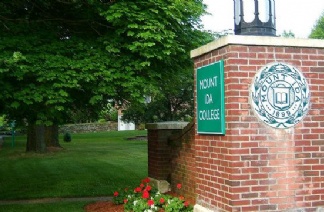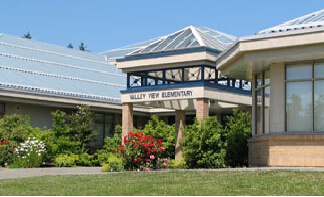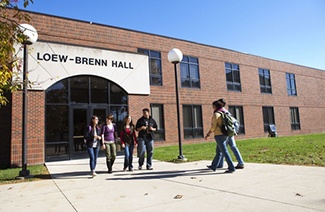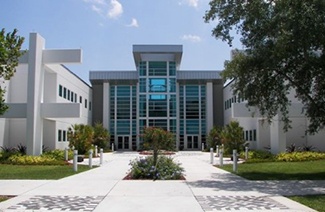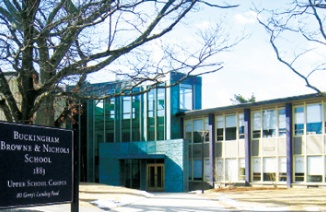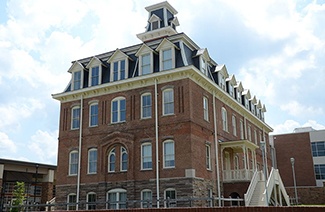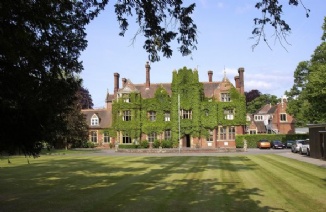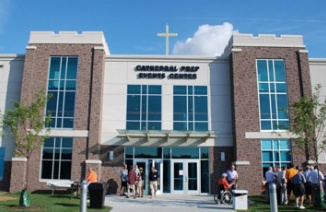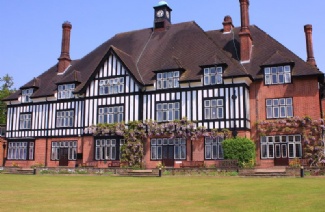为了帮助广大的
TPO1托福阅读Passage1原文文本
Timberline Vegetation on Mountains
The transition from forest to treeless tundra on a mountain slope is often a dramatic one. Within a vertical distance of just a few tens of meters, trees disappear as a life-form and are replaced by low shrubs, herbs, and grasses. This rapid zone of transition is called the upper timberline or tree line. In many semiarid areas there is also a lower timberline where the forest passes into steppe or desert at its lower edge, usually because of a lack of moisture.
The upper timberline, like the snow line, is highest in the tropics and lowest in the Polar Regions. It ranges from sea level in the Polar Regions to 4,500 meters in the dry subtropics and 3,500-4,500 meters in the moist tropics. Timberline trees are normally evergreens, suggesting that these have some advantage over deciduous trees (those that lose their leaves) in the extreme environments of the upper timberline. There are some areas, however, where broadleaf deciduous trees form the timberline. Species of birch, for example, may occur at the timberline in parts of the Himalayas.
At the upper timberline the trees begin to become twisted and deformed. This is particularly true for trees in the middle and upper latitudes, which tend to attain greater heights on ridges, whereas in the tropics the trees reach their greater heights in the valleys. This is because middle- and upper- latitude timberlines are strongly influenced by the duration and depth of the snow cover. As the snow is deeper and lasts longer in the valleys, trees tend to attain greater heights on the ridges, even though they are more exposed to high-velocity winds and poor, thin soils there. In the tropics, the valleys appear to be more favorable because they are less prone to dry out, they have less frost, and they have deeper soils.
There is still no universally agreed-on explanation for why there should be such a dramatic cessation of tree growth at the upper timberline. Various environmental factors may play a role. Too much snow, for example, can smother trees, and avalanches and snow creep can damage or destroy them. Late-lying snow reduces the effective growing season to the point where seedlings cannot establish themselves. Wind velocity also increases with altitude and may cause serious stress for trees, as is made evident by the deformed shapes at high altitudes. Some scientists have proposed that the presence of increasing levels of ultraviolet light with elevation may play a role, while browsing and grazing animals like the ibex may be another contributing factor. Probably the most important environmental factor is temperature, for if the growing season is too short and temperatures are too low, tree shoots and buds cannot mature sufficiently to survive the winter months.
Above the tree line there is a zone that is generally called alpine tundra. Immediately adjacent to the timberline, the tundra consists of a fairly complete cover of low-lying shrubs, herbs, and grasses, while higher up the number and diversity of species decrease until there is much bare ground with occasional mosses and lichens and some prostrate cushion plants. Some plants can even survive in favorable microhabitats above the snow line. The highest plants in the world occur at around 6,100 meters on Makalu in the Himalayas. At this great height, rocks, warmed by the sun, melt small snowdrifts.
The most striking characteristic of the plants of the alpine zone is their low growth form. This enables them to avoid the worst rigors of high winds and permits them to make use of the higher temperatures immediately adjacent to the ground surface. In an area where low temperatures are limiting to life, the importance of the additional heat near the surface is crucial. The low growth form can also permit the plants to take advantage of the insulation provided by a winter snow cover. In the equatorial mountains the low growth form is less prevalent.
TPO1托福阅读Passage1题目
第1题:The word"dramatic"in the passage is closest in meaning to
A.Gradual
B.Complex
C.Visible
D.Striking
Paragraph 1 is marked with
第2题:Where is the lower timberline mentioned in paragraph 1 likely to be found?
A. In an area that has little water
B. In an area that has little sunlight
C. Above a transition area
D. On a mountain that has on upper timberline.
Paragraph 1 is marked with
第3题:Which of the following can be inferred from paragraph 1 about both the upper and lower timberlines?
A. Both are treeless zones.
B. Both mark forest boundaries.
C. Both are surrounded by desert areas.
D. Both suffer from a lack of moisture.
Paragraph 1 is marked with
第4题:Paragraph 2 supports which of the following statements about deciduous trees?
A. They cannot grow in cold climates.
B. They do not exist at the upper timberline.
C. They are less likely than evergreens to survive at the upper timberline.
D. They do not require as much moisture as evergreens do.
Paragraph 2 is marked with
第5题:The word “attain ” in the passage is closest in meaning to
A. require
B. resist
C. achieve
D. endure
Paragraph 3 is marked with
第6题:The word “they ” in the passage refers to
A. valleys
B. trees
C. heights
D. ridges
Paragraph 3 is marked with
第7题:The word “prone ” in the passage is closest in meaning to
A. adapted
B. likely
C. difficult
D. resistant
Paragraph 3 is marked with
第8题:According to paragraph 3, which of the following is true of trees in the middle and upper latitudes?
A. Tree growth is negatively affected by the snow cover in valleys
B. Tree growth is greater in valleys than on ridges.
C. Tree growth on ridges is not affected by high-velocity winds.
D. Tree growth lasts longer in those latitudes than it does in the tropics.
Paragraph 3 is marked with
第9题:Which of the sentences below best express the essential information in the highlighted sentence in the passage? In correct choices change the meaning in important ways or leave out essential information.
A. Because of their deformed shapes at high altitudes, trees are not likely to be seriously harmed by the strong winds typical of those altitudes.
B. As altitude increases, the velocity of winds increase, leading to a serious decrease in the number of trees found at high altitudes.
C. The deformed shapes of trees at high altitudes show that wind velocity, which increase with altitude, can cause serious hardship for trees.
D. Increased wind velocity at high altitudes deforms the shapes of trees, and this may cause serious stress for trees.
Paragraph 4 is marked with
第10题:In paragraph 4, what is the author’s main purpose in the discussion of the dramatic cessation of tree growth at the upper timberline?
A. To argue that none of several environment factors that are believed to contribute to that phenomenon do in fact play a role in causing it.
B. To argue in support of one particular explanation of that phenomenon against several competing explanations
C. To explain why the primary environmental factor responsible for that phenomenon has not yet been identified
D. To present several environmental factors that may contribute to a satisfactory explanation of that phenomenon
Paragraph 4 is marked with
第11题:The word “prevalent ” in the passage is closest in meaning to
A. predictable
B. widespread
C. successful
D. developed
Paragraph 6 is marked with
第12题:According to paragraph 6, all of the following statements are true of plants in the alpine zone EXCEPT:
A. Because they are low, they are less exposed to strong winds.
B. Because they are low, the winter snow cover gives them more protection from the extreme cold.
C. In the equatorial mountains, they tend to be lower than in mountains elsewhere.
D. Their low growth form keeps them closer to the ground, where there is more heat than further up.
Paragraph 6 is marked with
第13题:Look at the four squares that indicate where the following sentence could be added to the passage.Where would the sentence best fit?
This explains how, for example, alpine cushion plants have been found growing at an altitude of 6,180 meters.
Paragraph 5 is marked with
第14题:Directions: An introductory sentence for a brief summary of the passage is provided below. Complete the summary by selecting the THREE answer choices that express the most important ideas in the passage. Some sentences do not belong in the summary because they express ideas that are not presented in the passage or are minor ideas in the passage. This question is worth 2 points.At the timberline, whether upper or lower, there is a profound change in the growth of trees and other plants.
1
2
3
A.Birch is one of the few species of tree that can survive in the extreme environments of the upper timberline.
B.There is no agreement among scientists as to exactly why plant growth is sharply different above and below the upper timberline.
C.The temperature at the upper timberline is probably more important in preventing tree growth than factors such as the amount of snowfall or the force of winds.
D.The geographical location of an upper timberline has an impact on both the types of trees found there and their physical characteristics.
E.High levels of ultraviolet light most likely play a greater role in determining tree growth at the upper timberline than do grazing animals such as the ibex.
F.Despite being adjacent to the timberline, the alpine tundra is an area where certain kinds of low trees can endure high winds and very low temperatures.
TPO1托福阅读Passage1解析
第1题:
正确答案:D
题目解析:"dramatic: 剧烈的,戏剧化的,就单词本身能够想到drama戏剧,所以这个应该是戏剧的形容词。A是逐渐的;B是复杂的;C是可见的;D是显著的,突出的,惊人的。根据词意,正确答案是D。
第2题:
正确答案:A
题目解析:以lower timberline做关键词定位至本段最后一句,说有lower timberline是因为a lack of moisture,缺乏湿度,等于A选项中的没有水。
第3题:
正确答案:B
题目解析:"分别以upper timberline和lower timberline为关键词定位至本段倒数两句,不管是upper timberline还是lower timberline都是快速的过渡带,树还是有的,只是在向草原等等过渡,所以A错,既然是过渡,也就是边界了,B对,C没说,只有lower timberline缺水,upper timberline 并没有说缺水,所以D错。"
第4题:
正确答案:C
题目解析:以deciduous trees做关键词定位至原文的第三句和第四句,根据第四句说有的地方的timberline是由落叶树构成的,所以timberline上还是有落叶树的,所以选项A和B说反,D项moisture原文没说,第三句说timberline通常是常绿树构成的,第四句说有的时候也出现落叶树,所以常绿树比落叶树出现的概率大,所以C正确。
第5题:
正确答案:C
题目解析:"attain: 获得。联想到相似的obtain(获得)和retain(保留)。A是要求;B是抵抗;C是获得;D是忍耐。根据词意,C是正确答案。
第6题:
正确答案:B
题目解析:"并列句,往前找,找主语,trees是正确答案,此外,被暴露在大风之下的应该是树,山谷山脊和高度都不靠谱。"
第7题:
正确答案:B
题目解析:prone: 有…的倾向。A是适应;B是很可能;C是困难的;D是抵抗的。根据词意,B是正确答案。对应原文:In the tropics, the valleys appear to be more favorable because they are less prone to dry out, they have less frost, and they have deeper soils.原文说热带地区山谷是更有利于生长的地方因为那里怎么样干涸,比较有利生长当然不容易干涸,C和D的意思都是能干涸,所以都不对,A适应不靠谱,所以B正确。
第8题:
正确答案:A
题目解析:以middle and upper latitudes做关键词定位至原文第三四两句,说中高纬度地区树木在很大程度上受到积雪覆盖的时长和深度的影响,山谷地区积雪深,时间长,所以树长得不好,所以是negatively affected,选项B和C与原文相反,D所做比较原文没有提到。
第9题:
正确答案:C
题目解析:"原句说风速增加而且会给树木很大压力,已经被blablabla证实。C是原句的忠实改写,所以C正确。A的因果关系在原文不存在,错;B数目减少没说到,错;D把原文非主要成分变成主要成分,改变了原文的结构,错。"
第10题:
正确答案:D
题目解析:以dramatic cessation of tree growth at the timberline为关键词定位至本段第一句,说对于这个cessation没有统一的解释,接着后面就说了有好多种解释,作者没说他认为哪个对,也没解释为什么没有一致意见,所以答案是D,提供了多种解释,A说所有都不对,B说支持其中一个,C说解释为什么没有一致意见都错了。
第11题:
正确答案:B
题目解析:"prevalent: 普遍的,常见的。A是可预测的;B是普遍的;C是成功的;D是发达的,成熟的。根据词意,B正确。
第12题:
正确答案:C
题目解析:EXCEPT题排除法,以wind做关键词定位至本段第二句,A对,不选;以winter snow cover做关键词定位至倒数第二句,B对,不选;以equatorial mountains做关键词定位至最后一句,原文说less prevalent,不那么广泛分布,不是选项C所说的低,所以C错,选;D选项与A选项在同一句,注意heat和higher temperature的替换
第13题:
正确答案:D
题目解析:"这道题如果单纯以cushion plants定位插入点的话一定会错,那个for example表明待插入句是around 6100m的一个例子,应该在C和D当中选择,而且待插入句中又有this explains how,就是说正确插入点之前的句子必须是对待插入句意思上的一个解释、原因,插入C点的话前面句子和待插入句之间不构成解释关系,所以D对。"
第14题:
正确答案:BDF
题目解析:A选项提到了具体的树种桦树,明显是一个细节选项,不选。B选项对应第四段首句,正确。 C选项错,原文没有将两者进行比较,即使比较了,也是个细节,不选。 D选项对应第二段的第三句和第三段的首句,正确。 E选项错,原因跟the temperature选项一样。 F选项对应原文的最后两句,正确。
上就是小编为同学们整理的TPO1托福阅读Passage1原文+题目+解析,托福备考的过程旅程是比较艰辛的,大家一定要平时多加练习,小编会每天为托福考生更新最新消息,关注相信你们每天都会收获的更多!


